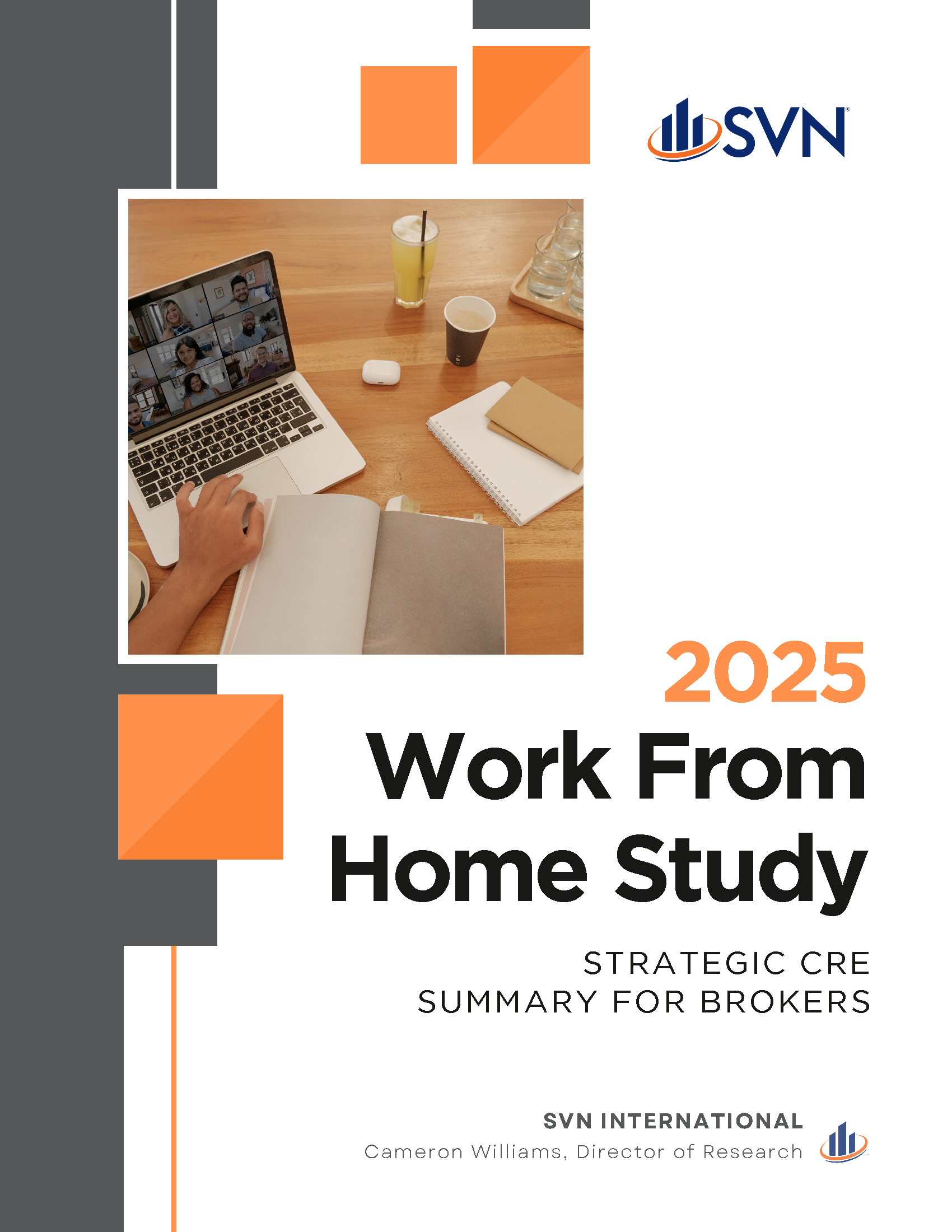

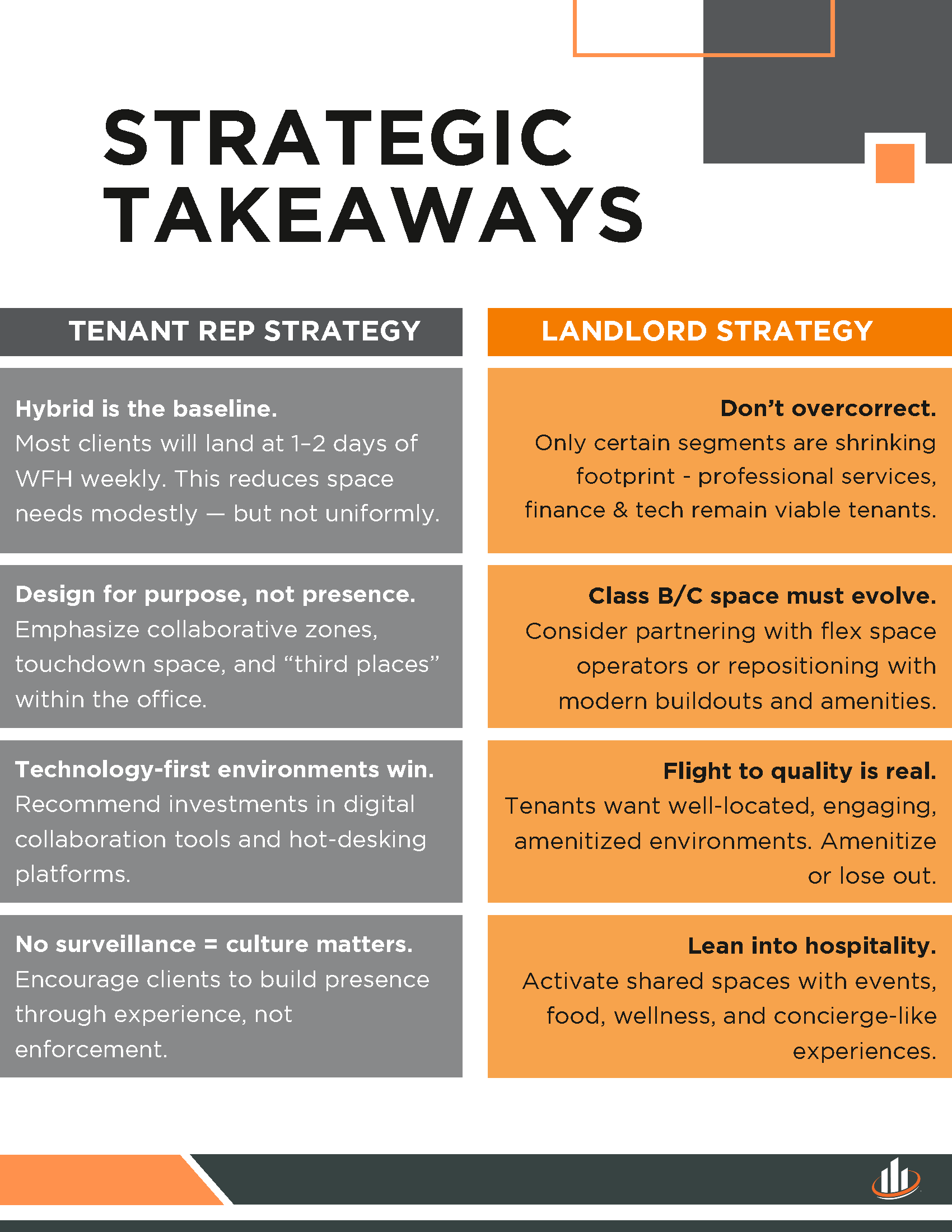
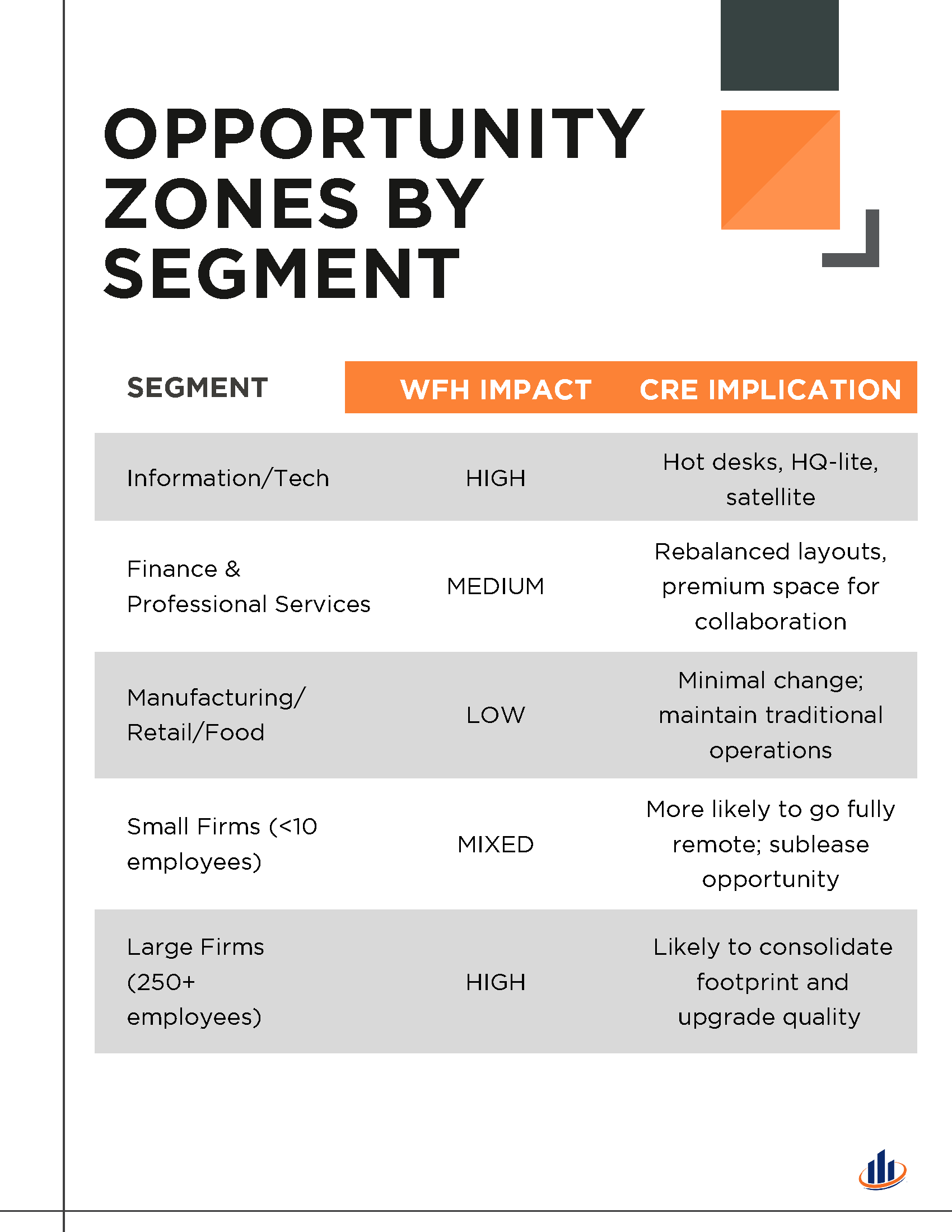
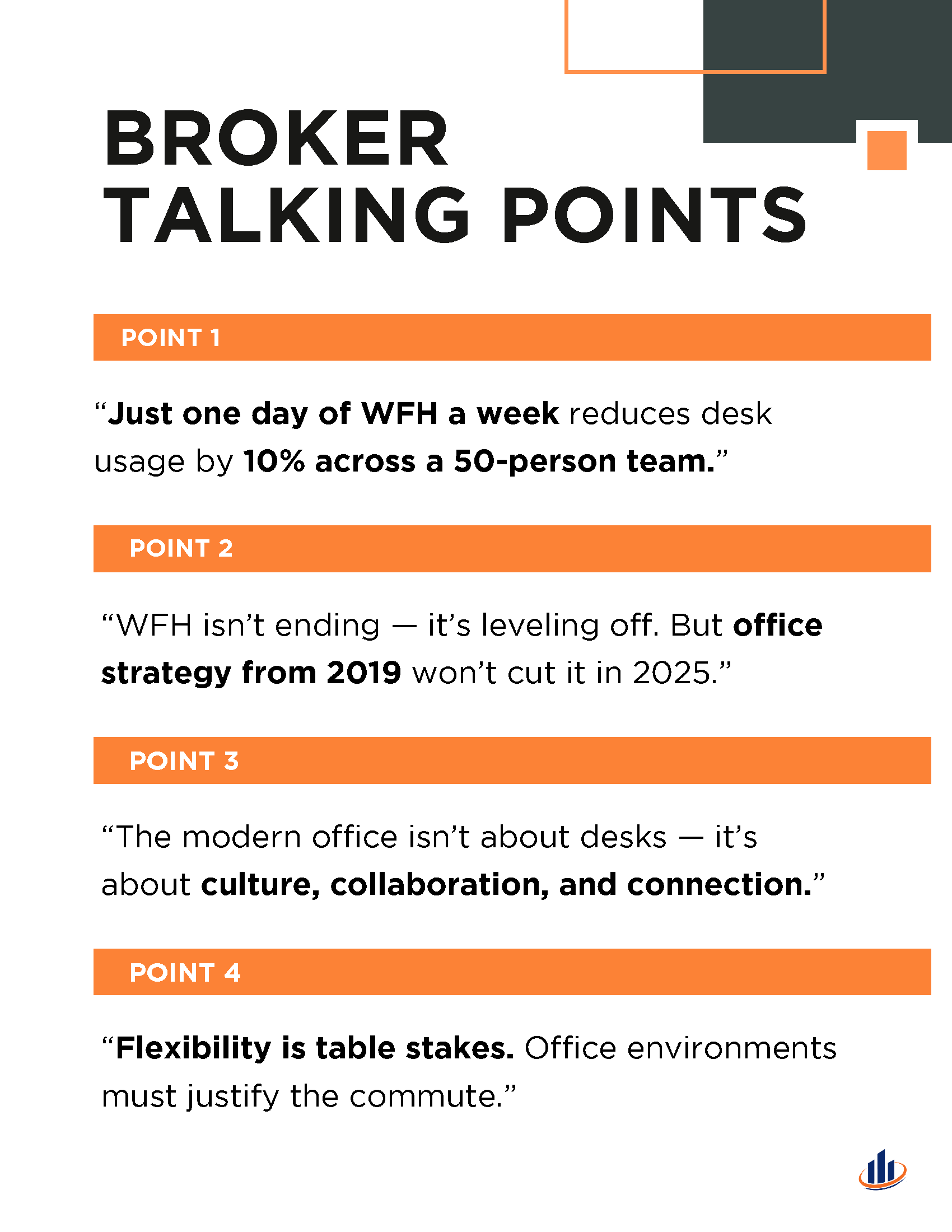
1. FED INTEREST RATE DECISION
- The Federal Reserve’s FOMC held rates unchanged at 4.25%-4.50% during its May policy meeting, aligning with market expectations leading up to the decision.
- While markets and experts largely expected the FOMC to keep rates steady in May, some expressed concern about leading anecdotal data, such as the Beige book, recently pointing to deteriorating conditions in the labor market, arguing that there could be room for a pre-emptive rate cut.
- However, despite Fed Chair Jerome Powell referencing the “great deal of uncertainty” around tariffs during his post-meeting press conference, he said that policymakers need not “be in a hurry to adjust its monetary policy” and that to wait-and-see remains “the appropriate thing to do.”
- Notably, within a few days of the May FOMC meeting, the Trump administration announced a 90-day pause on its ‘reciprocal tariffs’ against China. As a result, the CME fed futures markets are, on average, forecasting delayed and fewer rate cuts in 2025 relative to before the announcement of a tariff pause.
2. CPI INFLATION

- CPI inflation eased on an annual basis to 2.3% in April, its lowest annual reading since February 2021. Prices climbed 0.2% on the month.
- Core CPI prices increased 0.2% month-over-month and 2.8% year-over-year.
- While monthly readings edged higher compared to March, they largely fell short of market expectations and were seen as a positive sign in the face of fear of potential tariff-induced inflation.
- Shelter costs rose 0.3% during the month, accounting for more than half of the monthly gain in headline CPI.
- Energy prices rose by 0.7% month-over-month, driven by a rise in natural gas and electricity costs, while gasoline prices declined. Meanwhile, food prices fell by 0.1% in March.
3. SMALL BUSINESS OPTIMISM
- Small business optimism declined in April, according to seasonally adjusted data from the National Federation for Independent Businesses (NFIB).
- Optimism remained below its historical average for a second consecutive month as fewer owners expect to increase business investments in the near term.
- The net share of small business owners who expect better business conditions fell six points to a net 15% in April, its lowest share since October 2024.
- 34% of business owners expressed doubt in their ability to fill existing job openings, down percentage points from March. Interestingly, job openings are at their lowest level since January 2021.
- A net -4% of owners plan inventory investment in the coming months, down three points from March and its lowest reading since June of last year.
- 18% of owners are planning capital outlays in the next six months, down three points from March and its lowest since the depth of the COVID-19 pandemic in 2020.
- The most recent survey, conducted in April, does not capture the effect of the Administration’s announcement of a pause in its China tariff policy, which could meaningfully boost sentiment in the coming weeks.
4. CONSUMER CONFIDENCE
- According to data from the Conference Board, consumer confidence fell by 7.9 points in April to an index level of 86.0, its fifth consecutive monthly decline.
- Both consumers’ assessment of current business conditions and their short-term outlook for conditions shifted toward the downside, with the expectations index reaching a 13-year low.
- Forward-looking expectations deteriorated across the board, including expectations regarding future business conditions, employment prospects, and future income.
- Further, the share of consumers who expect fewer jobs in the next six months sits at 32.1%, roughly as high as in the middle of the Great Recession.
- The fall in consumer confidence was also broad demographically, falling amongst all age and most income groups and shared across all political affiliations.
- The decline was sharpest among consumers 35-55 years old and those making more than $125,00 per year.
5. CONSTRUCTION SPENDING
- US construction spending shrank by a seasonally adjusted 0.5% month-over-month in March, according to the latest available data from the US Census Bureau.
- High mortgage rates and tariffs on imports contributed to both a supply and demand-driven increase in construction costs, constraining homebuilding activity during the month.
- Private sector spending fell 0.6% in March, driven by pull-backs in both non-residential investment (-0.8%) and residential investment (-0.4%).
- Public sector spending fell 0.2%, primarily due to a fall in non-residential investment and reduced spending on power, commercial, and amusement and recreation construction. Office and transportation construction experienced some of March’s most significant spending increases.
- Annually, US construction spending is up 2.8% through March.
6. SPECIAL SERVICING RISES IN APRIL
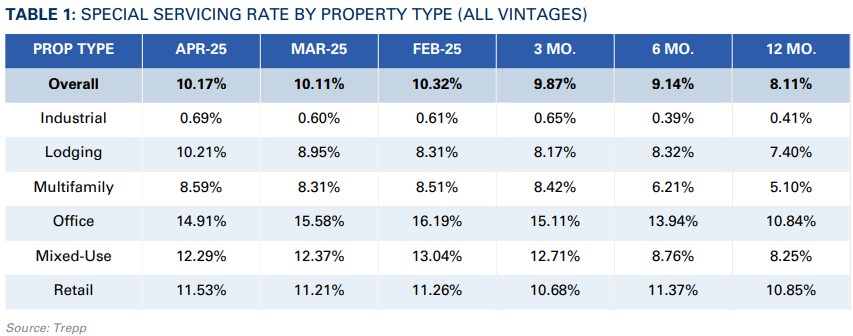
- According to Trepp, the special servicing rate for CMBS loans rose six basis points (bps) to 10.17% in April.
- While April’s increase was relatively modest, the industry-wide special servicing rate sits well above the 8.11% charted one year ago and the 5.62% registered in April 2023.
- There were significant variations in sector-level performance during the month. Lodging continued to chart the most significant increase, climbing 126 bps to 10.21% in April and following a 64 basis point jump in March.
- Multifamily and Retail also saw special servicing rates climb during the month, rising roughly 30 basis points each. Industrial rose just nine bps.
- Office saw some relief as its rate dropped by 68 basis points, a repeat of March, to 14.91%.
7. LOGISTICS MANAGERS’ INDEX
- Logistics activity rose in April following a slowdown in March, according to the latest reading of the Logistics Managers’ Index.
- Logistics activity was elevated to start the year as North American firms attempted to front-run a potential trade war before snapping back in March. April’s rebound reflects a growth level more consistent with logistics sector performance before the 2024 Presidential Election.
- Inventory levels rose but at a much slower pace compared to activity experienced during the first quarter, reflecting a more normal seasonal inventory buildup.
- Despite lower inventory growth, warehousing prices and inventory costs climbed faster than the previous month, suggesting that much of the first-quarter inventory buildup remains sitting in storage facilities.
8. COMMERCIAL PROPERTY PRICES
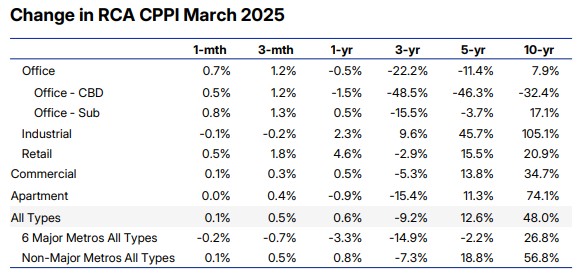
- Commercial property prices rose 0.6% year-over-year in March as commercial real estate gradually edges into a faster pace of annualized growth. Further, a quarter-over-quarter gain of 0.5% during Q1 puts the pace of annualized growth at 1.8%.
- According to the monthly update by MSCI-Real Capital Analytics, CRE prices have not yet responded to the spike in uncertainty that has accompanied recent trade negotiations and policy rollouts.
- Rather, CRE still exhibits the uneven price performance across sectors that has persistent since 2022.
- Retail led all sectors during Q1, rising 1.8% from Q4 2025 and 4.6% year-over-year.
- Industrial, which has typically seen the strongest price growth of any sector during the post-pandemic period, followed Retail with a 2.3% year-over-year increase during Q1 but declined 0.2% from Q4.
- Apartment prices declined 0.9% year-over-year during Q1 but climbed 0.4% quarter-over-quarter, its second consecutive quarter of growth, suggesting that price stagnation is gradually thawing in the sector.
- CBD office prices were down just 1.5% year-over-year in Q1, a significant turnaround from the more than 30% recorded one year ago. Suburban office prices rose 0.5% year-over-year during Q1.
9. GDP
- Real US GDP contracted at an annualized rate of 0.3% during the first quarter of 2025, based on the advance estimate from the US Bureau of Economic Analysis.
- The first-quarter decline was primarily due to a sharp increase in imports, which is a negative factor in the GDP calculation. GDP’s other components—consumer spending, investment, and exports—each also increased, partly offsetting the downside effect of imports.
- Beneath the surface, the US economy still exhibits strong fundamentals. The rise in imports during the first quarter was significantly driven by US firms and consumers, who front-loaded their purchases of goods in anticipation of the Trump Administration’s tariffs.
- It reflects robust consumer spending despite softening consumer sentiment. Nonetheless, the first-quarter numbers indicate that consumers and producers significantly adjusted their activities in anticipation of heightened trade tensions.
10. APRIL JOBS REPORT
- The US Economy added 177k payrolls in April, above consensus estimates of 130k, according to the Bureau of Labor Statistics (BLS). The unemployment rate was unchanged at 4.2%.
- It was a strong showing for firms despite being a month headlined by heightened economic uncertainty and volatility. April’s job growth slightly edged out the average monthly increase of 152k over the previous 12 months.
- Payrolls grew the most in the healthcare sector (+51k), transportation and warehousing (+29k), and financial activities (+14k). The increase in transportation and warehousing employment comes after little change in March and arrives after an uptick in logistics activity, including imports and inventories, to start the year. Federal government employment continued to decline (-9k).
SUMMARY OF SOURCES

SHAREABLE FLIPBOOK DOWNLOADABLE PDF
1. SMALL BUSINESS OPTIMISM DECLINES
- According to the National Association of Independent Business (NFIB) in March, small business optimism experienced its most substantial decline in nearly three years, driven by a collapse in expectations around future business and sales conditions.
- The share of owners who expect better future business conditions fell by its largest monthly amount since December 2020, declining to just 21%. Meanwhile, just 3% of owners expect real sales to be higher in the short term, down from 14% in February.
- Notably, the identical items that saw the largest boost to sentiment following the November 2024 election experienced the steepest declines in March.
- Other components that measure ongoing business conditions, such as the share of owners reporting plans to increase employment, capital outlays, or expand their business, remain roughly in line with where it was pre-election.
2. CONSUMER CONFIDENCE TRACKING
- Morning Consult’s daily index of consumer sentiment (ICS) shows that from April 3rd to April 7th, consumer confidence experienced its second-largest three-day drop since tracking began in 2018, behind only reactions to the onset of COVID-19 in March 2020.
- The April 7th reading was the lowest since July 2024. Following the 2024 election, US consumer confidence experienced a rapid upswing, reaching a five-year high by January 21st, but has fallen steadily in the past several weeks.
- Consumer and business confidence indices have recently reacted to the US administration’s tariff announcements, but the impact on spending is less clear. Consumer spending was weaker than expected in February, but some forecasters foresee an Easter spending pick-up despite higher uncertainty.
3. LOGISTICS MANAGERS’ INDEX
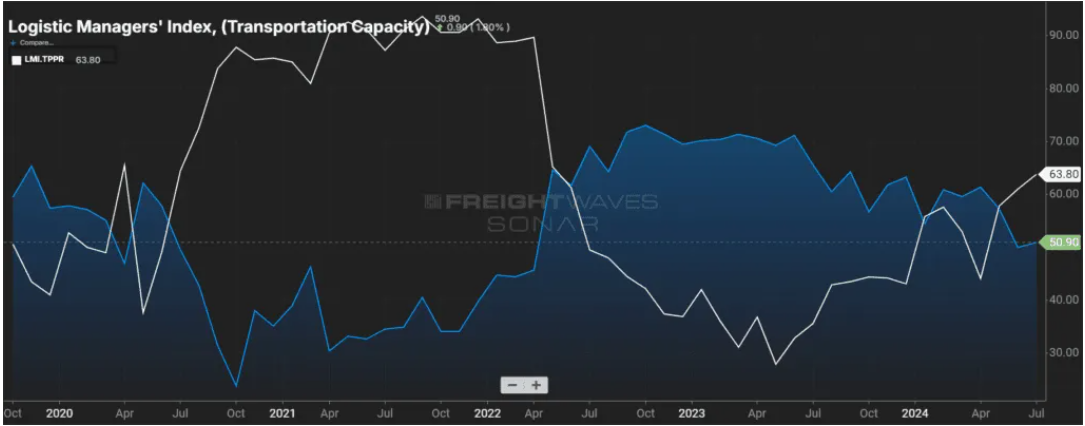
- The US Logistics Managers’ Index (LMI), a leading indicator for Industrial Real Estate activity, fell from 62.8 in February to 57.1 in March. A mark above 50 indicates that logistics activity is expanding.
- This month’s drop is the third largest in the index’s history and marked the shortest expansion in logistics activity in seven months. However, for context, February’s LMI reading was the highest since June 2022.
- The decline was led by an across-the-board drop in index components prices, including inventory costs, warehouse prices, and transportation prices.
- The broad price decrease lends credibility to the view that logistics activity ramped up to start the year in anticipation of tariff risks, but that activity has since subsided.
- Additionally, inventory levels and warehouse and transportation capacity each expanded at a slower pace in March.
4. MEDICAL OUTPATIENT SPACES

- Medical outpatient buildings (MOB) are emerging as an opportunity in an otherwise challenging market, as explored in a recent piece by Globe Street.
- Asking rents rose 2.5% in 2024, slower than the 3.7% in 2023, but premium properties continue to drive rent growth in the sector.
- Properties with rents in the 90th percentile of Revista’s top 100 markets achieved an average of 2.4% in NOI growth between 2019 and 2024 compared to an average of 1.8% growth for properties near the 50th percentile.
- Tenant retention has also been key to MOB’s appeal. Healthcare providers typically operate on longer lease terms while renewing at high rates.
- According to data from Green Street, over 80% of tenants renewed MOBs in Q3 2024. New leases average a commitment of 107 months, nearly nine years. Meanwhile, vacancy rates remain relatively low, at just 6.9% through Q4 2024.
5. APARTMENT CONSTRUCTION & DEVELOPMENT ACTIVITY

- According to the National Multifamily Housing Council (NMHC)’s latest quarterly construction survey, 58% of respondents reported experiencing construction delays during the first quarter, down from 78% at the end of Q4 2024.
- The Southeast stands out as an area where delays are more widespread, followed by Texas and, to a slightly lesser extent, the mid-Atlantic and the Rockies.
- Of those experiencing delays during Q1, 79% are experiencing permitting delays, a drop from a record high of 95% of respondents in Q4 2024. The share of respondents reporting delays in starts rose from 90% to 93%, its highest share since June 2022.
- The most frequently cited causes of delays in starting during the first quarter were economic uncertainty and economic feasibility, each at 68% of respondents. Permitting, entitlement, and professional services are also cited to a slightly lesser extent but still affect more than half of all respondents.
- Availability of construction financing and staffing shortages continue to decline as reasons for delayed starts.
6. MARCH JOBS REPORT
- According to the Bureau of Labor Statistics (BLS), the US added 228k jobs in March, well above projections of 140k jobs and climbing from 117k in February. The unemployment rate increased 10 basis points (bps) to 4.2%.
- Health care, transportation, and warehousing were once again among the key sectors driving employment growth.
- Federal government jobs continued to shrink in March as large cuts to the federal workforce that began in February continued to take shape. Federal government jobs declined by 4,000 in March following an 11,000 decline in February.
- Despite payrolls coming in higher than expected, futures markets shifted toward a more dovish outlook for policy following the data release.
- Year-end projections for the Federal Funds rate went from a 78.7% probability of no more than four (4) rate cuts between now and the end of the year to a 51.1% probability of at least five rate cuts.
7. EASTER SHOPPING SEASON
- The National Retail Federation projects that Easter shoppers are expected to spend $23.6 billion during the spring 2025 holiday, up from the $22.4 billion estimated total in 2024.
- The report forecasts that Americans will increase their spending this year despite a recent uptick in economic uncertainty.
- Discount stores are expected to once again be the top destination for seasonal shopping. The price of eggs, a traditional item used for Easter festivities, has nearly doubled in the past year.
- Major retailers, who experienced robust sales numbers during the December 2024 holiday season, are expecting a similar pattern during the upcoming holiday, believing that consumers who feel constrained by other costs may view the holiday season more favorably.
8. TOP STATES FOR UNDER-35 HOMEOWNERS
- According to a Chandan Economics analysis of the American Community Survey, Texas, California, and Florida have the greatest number of households headed by someone under 35.
- Meanwhile, Utah (11.6%), Alaska (10.2%), and Iowa (10.1%) maintain the highest proportion of U35 homeowners as a share of all households in the nation, with North Dakota (10.0%) and Wyoming (9.6%) rounding out the top 5.
- The states with the highest totals tend to also have the most homeowners under 35 and generally rank near the top for renters.
- Conversely, the highest shares of U35 homeowners as a percent of all households reveal where young, first-time homebuyers face fewer barriers to ownership.
- States that rank in the bottom ten for a share of U35 homeowners are among some of the highest for average hourly wages. This includes DC, which is the lowest in terms of U35 homeowner share (3.5%) but highest in average hourly wage ($55.02). Also ranking in the bottom five are California (4.6%) and New York (4.8%), followed by Hawaii (5.1%) and Nevada (5.4%).
9. WFH RENTAL DEMAND
- According to a Chandan Economics analysis of the US Census Bureau’s American Community Survey, there are 4.0 million rental units in the US headed by someone who works from home (WFH), down from 4.5 million in 2022, representing a 9.9% decline.
- It’s the second consecutive year that WFH rentals have fallen, following the peak of 5.0 million households in 2021. Between 2021 and 2023, WFH rental demand has slid by a total of 1.0 million households (-20.1%).
- WFH renters skyrocketed by more than 200% in 2020 and rose again by about 18% in 2021.
- Despite the past two years of declines, the nature of remote vs. in-person work remains in a very different place than it was entering the pandemic. Through 2023, the total number of full-time WFH workers (22.6 million) remains up by 152% compared to pre-pandemic.
- The disentanglement of local rent prices from local wage dynamics had a major impact on rental markets in the aftermath of the pandemic. Now, while the reversion process will be more gradual, a re-anchoring appears underway.
10. FOMC MEETING MINUTES
- According to the recently released minutes from the Fed’s March policy meeting, there was broad agreement to keep rates unchanged while policymakers continue to assess the outlook for labor markets and growth in 2025.
- Members, on average, expect inflation to be pushed higher this year due to the impact of tariffs. However, the committee collectively acknowledges that there is much uncertainty around the magnitude of tariff effects or their duration.
- Meanwhile, a majority of officials believe that inflation pressures more broadly could be more persistent than previously anticipated.
- Most FOMC members view inflation risks as tilted to the upside, while employment risks are facing the downside.
SUMMARY OF SOURCES
1. CPI INFLATION
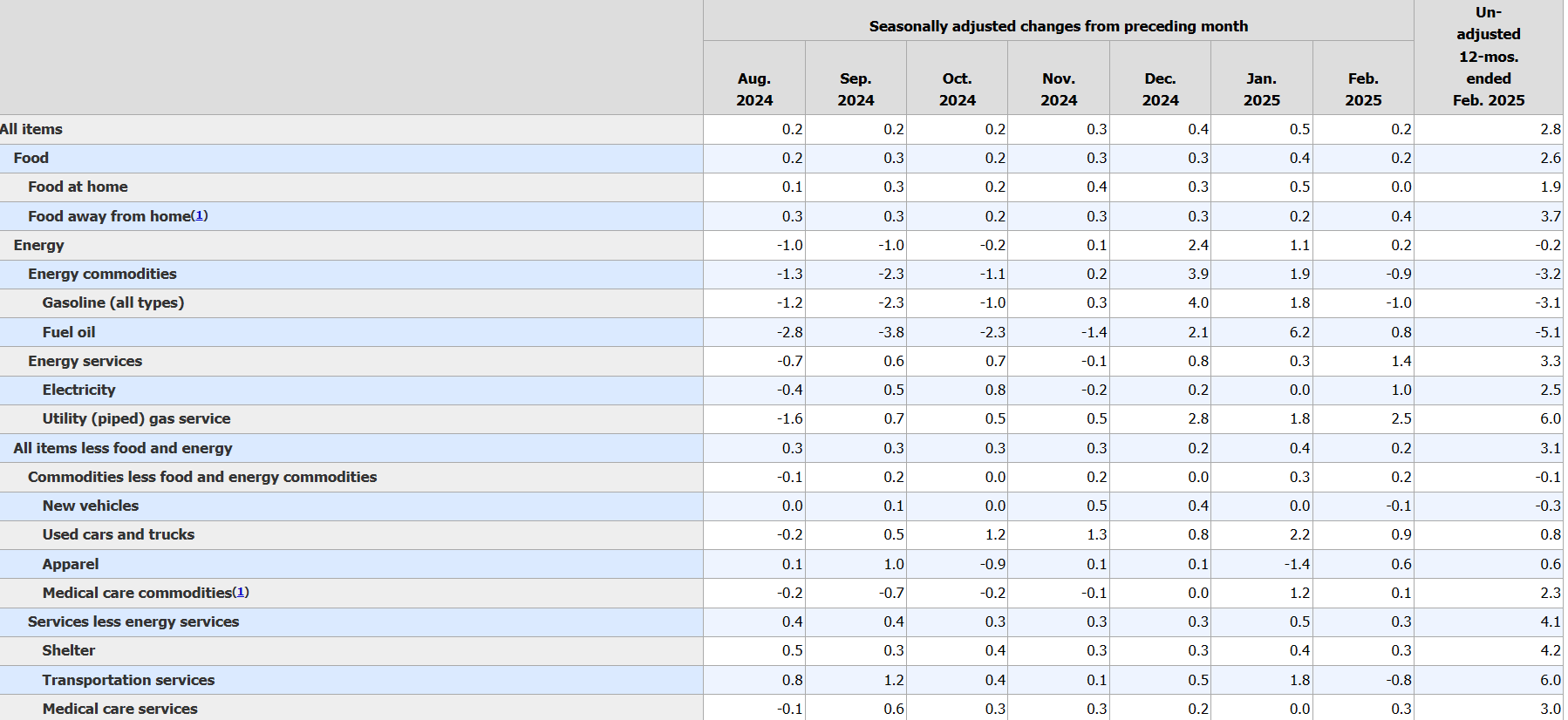
- The Consumer Price Index (CPI) rose 0.2% in February and 2.8% year-over-year, cooling more than expected and potentially providing some relief to markets and policymakers on guard about price pressures.
- Core-CPI, which removes the more volatile food and energy components, mirrored the headline 0.2% month-over-month figure but arrived slightly higher on an annual basis at 3.1%. Nonetheless, Core CPI also fell short of Wall Street’s consensus forecast, with economists expecting a 0.3% month-over-month increase in both the headline and core numbers.
- Shelter costs notably decelerated from January (+0.35 month-over-month) but remain responsible for roughly half the monthly increase in headline CPI. Further, since shelter makes up about one-third of the CPI weight, it managed to push core inflation above the headline metric this month even as food and energy prices were on the rise.
- Food and energy prices each rose by 0.2% in February, with eggs soaring another 10.4% in the month—taking its 12-month increase to a massive 58.8%. Beef prices also rose 2.4%
- This month’s CPI release comes amid a flurry of economic policy moves by the White House that could have both short- and long-term implications on growth and inflation. Both stock market futures and treasury yields rose following the Wednesday CPI release.
2. BUSINESS OPTIMISM DECLINES
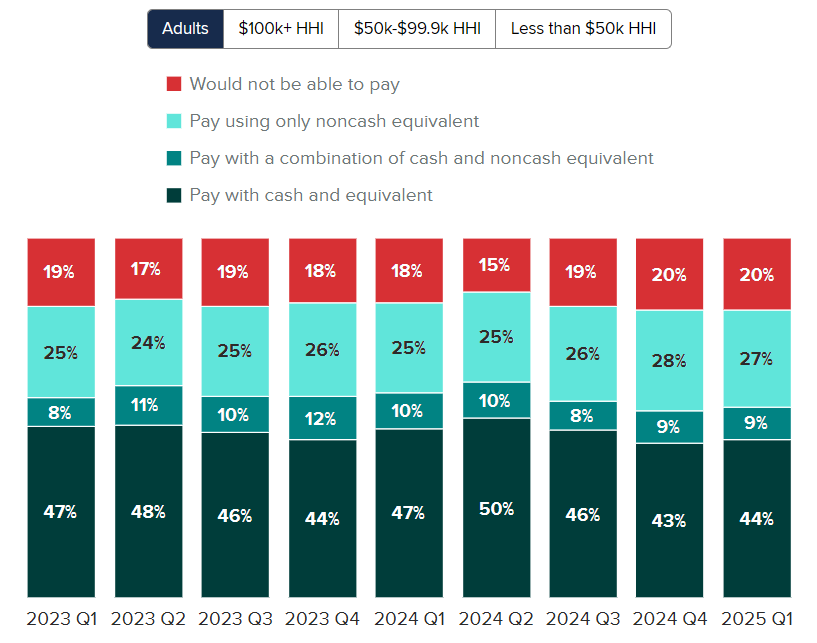
- Business optimism took a significant dive in February, according to the National Federation of Independent Businesses (NFIB). The Business Optimism Index fell 2.1 points from January, which puts it at its lowest level since October, just prior to the 2024 presidential election.
- Also notable, a supplemental indicator of the index that measures uncertainty has surged to its second-highest level on record, beaten only by the initial uncertainty surrounding COVID-19.
- Expectations for the next six months declined, as did the share of business owners who believe now is a good time to expand their business. Labor quality and inflation continue to be the main concerns of business owners.
3. TARIFFS, UNCERTAINTY, AND REAL ESTATE
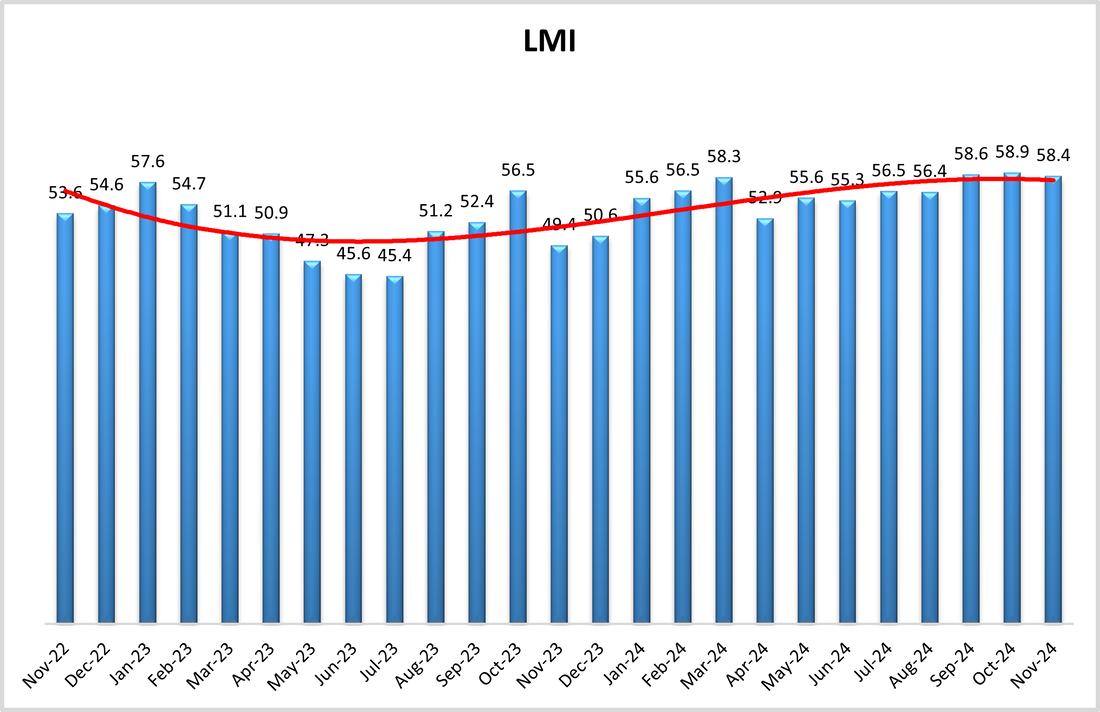
- The US Logistics Managers’ Index (LMI) came in at 58.4 in November, a slight downtick from October’s level but marking the 12th consecutive month of growth for the logistics industry. Logistics activity is a leading indicator of Industrial Real Estate demand.
- Inventory levels were down, in line with seasonal patterns, which saw warehouse utilization fall and capacity rise. The drop off in inventory also caused transportation capacity to expand and prices to fall.
- According to the reporting, inventory costs and warehousing prices saw the fastest growth, reflecting higher costs as more inventory is now held closer to consumers.
4. MARCH JOBS REPORT
- According to the Bureau of Labor Statistics, the US economy added 151k jobs in February, a rebound from a downwardly revised 125k additions in January but short of the 170k job additions that were expected.
- Job growth in health care, finance, as well as transportation and warehousing led job growth for the month, while federal government and retail trade drops saw some of the most notable declines.
- Average hourly earnings rose 0.3% month-over-month and rose annually by 4%.
- Treasury yields fell slightly, and fed futures forecasts consolidated around a projection of two rate cuts in 2025. However, with a flurry of economics-related developments arriving in the days since, the jobs data had little lasting impact on markets.
5. COMMERCIAL PROPERTY PRICES
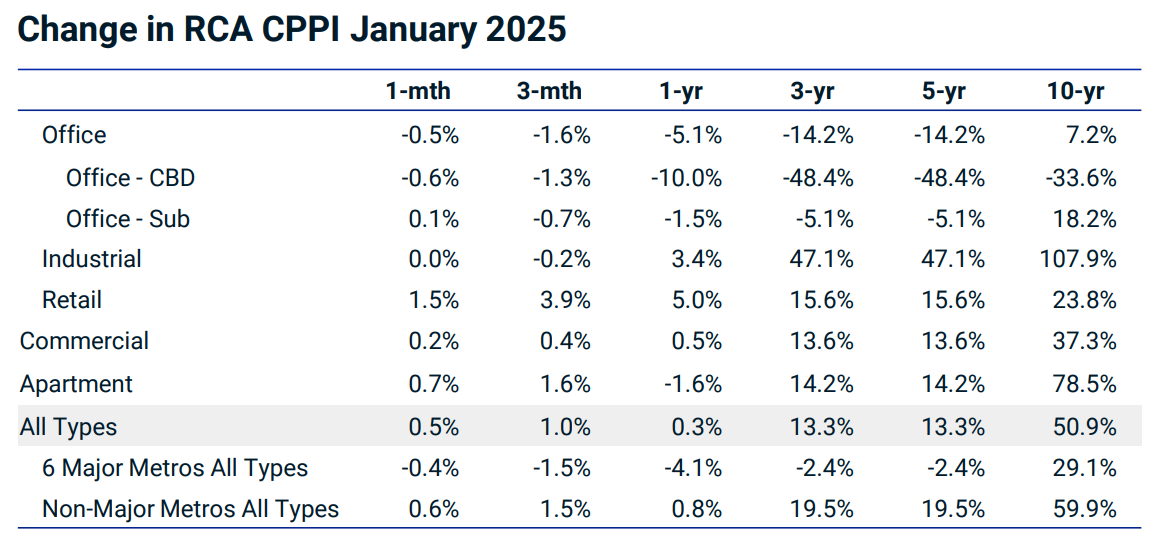
- Commercial real estate prices edged into year-over-year growth in January and posted their third consecutive monthly increase, according to the latest Commercial Property Price Index (CPPI) data from MSCI-RCA.
- Overall, commercial prices are up 0.5% from December and 0.3% over the past twelve months. Moreover, monthly price growth is accelerating, implying a faster annualized growth pace if the trend continues.
- The Retail sector led all property types in price momentum during both January and over the past year, rising 1.5% and 3.8%, respectively.
- Prices in the Industrial sector were unchanged on a monthly basis but Industrial joined Retail as the only property type to experience an annual increase in prices through January, climbing 3.4%.
- Apartment prices in the CPPI rose 0.7% in January, and though still negative year over year, the sector is gradually beginning to show positive momentum since prices hit a floor in August 2024.
- CBD office properties fell 0.6% from December despite signs during the fourth quarter that price declines were slowing. Suburban office prices are up 0.1% month over month and down 1.5% year over year.
6. FALLING CRE DISTRESS
- According to reporting from CRED iQ, distress for both conduit and single-borrower large loan deal types dropped for the first time in five months during February.
- This comes after MSCI reported in its January US distress tracker, which combines delinquencies and special servicing rates, that levels had reached their highest in a decade.
- Distress levels dropped 70 basis points in January to 10.8%, breaking a streak of four consecutive highs.
- Office distress continues to climb, however, reaching 19.3%.
- Looking at the components of the distress metric, delinquencies, as measured by CRED iQ, fell from 8.9% to 8.0% in February. The special servicing rate dropped 20 basis points to 10.1%. For context, one year ago, the delinquency and special servicing rates were 5.4% and 7.0%, respectively.
- Among property types, self-storage saw the largest downward move, but this was caused by a $2 billion portfolio reaching maturity, drastically skewing results.
- Elsewhere, Industrial distress fell 110 basis points to a CRE-low 0.5%. Hotel distress fell 20 basis points to 10.2%, with Retail dropping by the same amount but hovering a bit higher at 10.7%. Multifamily distress rose 10 basis points to 13.0%.
7. LOGISTICS ACTIVITY
- Logistics activity rose for a second consecutive month in February and, like in January, charted its strongest growth since June 2022, according to the Logistics Mangers’ Index (LMI)
- A notable uptick in inventory levels drove logistics activity growth, with both upstream and downstream firms expanding. LMI researchers note that expanding inventories across the supply chain is similar to a dynamic observed last year, but overall, expansion levels are elevated.
- According to the report, February’s inventory increases were at least partially driven by shifting trade dynamics. As a result, inventory and warehousing prices rose at their fastest pace in several years.
- Further, transportation capacity started to loosen during the latter half of the month, suggesting that much of the trade-related inventory buildup occurred at the start of the month before becoming more static as uncertainty rose among firms and consumers.
8. CONSTRUCTION PLANNING ACTIVITY FLATTENS
- According to the Dodge Construction Network’s momentum index (DMI), construction activity grew 0.7% in February while planning activity moderated.
- Commercial planning rose 3.3% during the month, while institutional planning fell 4.6%, leading to a mostly flat period for overall activity.
- Data center activity is propping up growth in the overall DMI, which, according to the researchers, would have contracted by 2% in February if data center growth had been removed.
- Increased uncertainty around material prices and fiscal policies is believed to be weighing on planning decisions, but for now, existing plans are moving forward.
- On the commercial side, data center, traditional office building, and retail planning led gains, while weaker education planning placed downward pressure on industrial planning actvitiy.
- The DMI remains up 27% compared to one year ago, but this has been driven by the commercial segment, where activity is up 43% year-over-year, while the institutional segment is up by a tepid 2% over the same period.
9. HOUSEHOLD UTILITY COSTS
- According to a recent analysis by Chandan Economics, the average US renter household pays $220 per month in utilities, and the costs vary widely by property type.
- On an absolute basis, tenants living in single-family rentals (SFR) pay considerably more in average utilities—about $327 per month, 56% higher than the next closest property type.
- These higher costs are typical for homes with larger square footage, explaining the consistently higher totals for SFR, but utility costs remain higher for SFR even on a relative basis.
- Utilities account for 18.3% of gross SFR housing costs, but this figure falls to 14.8% for 2-4 family rentals, 10.5% for small multifamily units, and 7.9% for large multifamily units.
- Because larger property types have more unit density, average utility costs fall in absolute and relative terms due to synergies gained from shared walls and centralized energy systems, which allow for more energy efficiency.
- While technological advances have helped level the playing field across residential property types, density remains a powerful driver of efficiency and cost savings.
10. GEOGRAPHIC DIFFERENCES IN CREDIT ACCESS
- A recent study by the New York Federal Reserve finds that residents in urban areas, specifically West Coast metros, have better access to credit on average than residents of other regions of the country.
- The study reports that between 2018 and 2023, rural areas had consistently worse credit health than urban areas. Further, 85% of the top 25 cities for credit access were on the West Coast or in the region near Minneapolis.
- Outside of these regions, credit security was highest in and around Chicago, Indianapolis, Washington D.C., and Raleigh.
- Cities with the least credit access were more geographically distributed, but many were around former industrial towns, such as Detroit and Syracuse, or college towns, including Gainesville (FL), Tuscaloosa (AL), and College Station (TX). In the latter cases, a larger share of the population is made up of students who are less likely to have a credit history, explaining some of the pattern.
SUMMARY OF SOURCES
1. CPI INFLATION
- Consumer prices rose 0.5% from December and 3.0% year-over-year, according to the latest data from the Bureau of Labor Statistics.
- The typically more volatile food and energy prices were key contributors to the increase, but core prices, which remove the items, were also up 0.4% on the month and 3.3% over the past year.
- Food price increases mostly reflected an uptick in grocery prices, which rose 0.5% in January, primarily driven by a nationwide egg shortage following an outbreak of avian flu. Egg prices are up 15.2% over the past four weeks.
- Gasoline prices also climbed, up 1.8% in January, but are down 0.2% from one year ago. Fuel oil rose 6.2% month-over-month.
- The shelter index continues to add upward pressure to CPI, accounting for roughly 30% of the monthly increase in the headline index. The shelter price increase in January is accelerated relative to its November and December levels.
2. CONSUMER SENTIMENT
- Consumer sentiment declined for a second consecutive month and dropped to a seven-month low, according to preliminary data from the University of Michigan. The index is down by 4.8% from January and 11.8% year-over-year.
- Sentiment fell across all key cohorts measured, including among consumers of different age groups and wealth levels and voters of both parties.
- The index also deteriorated among all of its sub-components but was led by falling sentiment surrounding buying conditions for durable goods. This was partly due to a perception that it may be too late to avoid the negative impacts of tariff policy.
- Expectations around personal finances also fell, while consumers increasingly worry that higher inflation could return within the next year, though alternate measures of inflation expectations dispute the latter.
3. INFLATION EXPECTATIONS
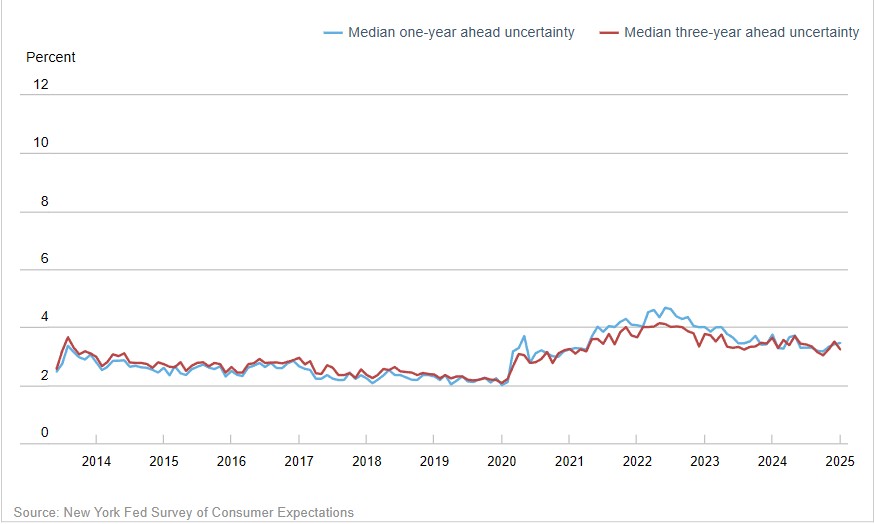
- According to the New York Federal Reserve’s Survey of Consumer Expectations, consumer inflation expectations appear stable, conflicting with signals from the University of Michigan’s assessment over a similar period.
- Both the one- and three-year-ahead expectation indices remained unchanged at 3.0% year-over-year. Households also expect to spend less relative to their sentiment one month ago, amounting to an expectation of 4.4% spending growth over the next year— the lowest reading since January 2021.
- The NY Fed index historically tracks better with inflation metrics compared to the University of Michigan measure. While the NY Fed index currently shows that inflation expectations are stable, its index of inflation uncertainty remains significantly elevated relative to pre-pandemic levels.
4. INTEREST RATE FORECASTS
- Forecasts for the median year-end federal funds rate shifted significantly in the past week as consumer prices accelerated more quickly than expected in January, causing markets to adopt a more hawkish outlook for rates.
- By the end of the trading day on February 12th, the same day that the January CPI data was released, futures markets placed a majority 40.1% probability on just one rate cut by the end of the year. Just one week ago, markets placed a majority 32.4% probability of two rate cuts.
- While January’s inflation report follows several months of encouraging data, the acceleration will certainly test an FOMC already keeping its eyes peeled for a dislocation of forward-looking inflation expectations.
- Assuming the Fed’s preferred gauge, the PCE price index, mirrors the rise in core consumer prices; it will at least keep policymakers on hold through their next rate decision.
- Inflation expectations appear stable now, but January’s price acceleration risks filtering into those expectations.
5. POWELL TESTIFIES TO CONGRESS
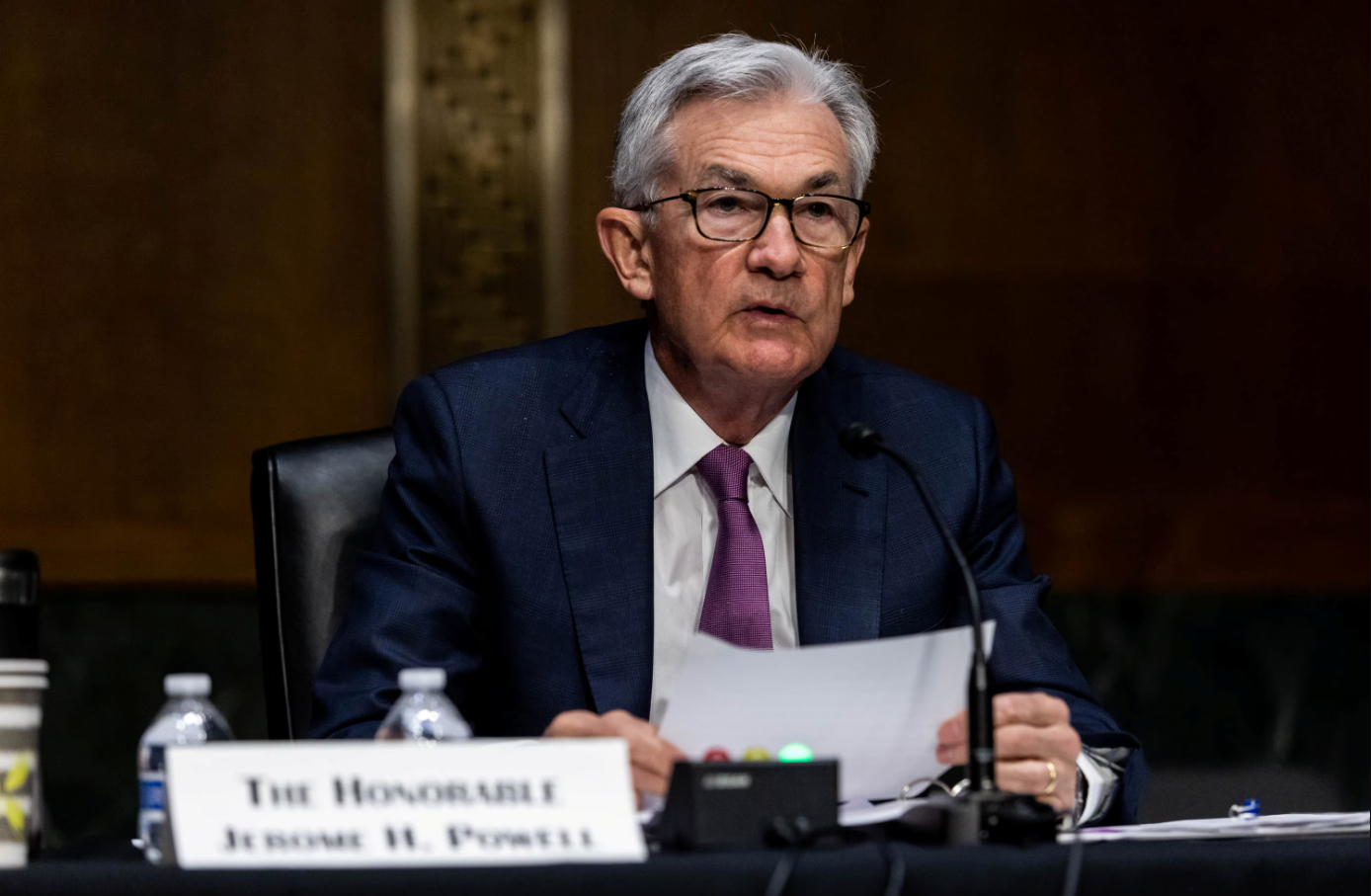
- On February 12th, Fed Chair Jerome Powell testified in front of the new Congress for the first time, offering clues to the central banker’s outlook on the US economy and policy expectations.
- Powell reiterated the consensus FOMC view that the economy remains on a firm footing, supported by a less restrictive policy stance that he expects will hold for some time.
- Echoing comments made during his post-meeting press conference in January, Powell said that the combined potential for changes to trade, immigration, fiscal, and regulatory policies make it nearly impossible for the central bank to make clear policy judgments at this time.
- In the Fed’s upcoming framework review researchers will examine pandemic-era rate strategies where policymakers contended with trying to accommodate the economy while rates remained at historically low levels.
- Officials took a flexible approach to inflation targeting during the 2020 rebound, with some viewing that a brief period of above-target inflation could offset the long-term effects of historically low inflation during the last decade. Following a sustained period of above-average inflation, the approach was challenged, but Powell signals it’s a key part of a once-every-five-year review.
6. OFFICE VACANCY FORECASTS
- According to recent reporting from Hines, a leading global property manager, researchers expect the Office sector to continue to see rising vacancies through at least 2028 in most scenarios, though second-tier assets will continue to experience increased absorption over the next year.
- Illustrating the sector’s progress in finding its bottom, Hines points out that its own tenants returned an average of about 10% of leased space following lease expirations during 2024 compared to roughly 33% returned 12-18 months prior.
- Looking more medium-term, Hines forecasts that in a medium-case scenario where office usage gets halfway back to its pre-pandemic trend, vacancy rates will fall by about 1000 basis points by 2028. The national vacancy rate stands at 19.8% year-over-year.
7. LOGISTICS ACTIVITY
- In January, US logistics activity, a key indicator of Industrial Real Estate demand, rose at its fastest pace since June 2022, according to the Logistics Managers’ Index report.
- Reflecting activity seen toward the end of 2024, January’s increase comes amid a spike in imports driven by North American firms ramping up purchases ahead of anticipated tariffs. It also reflects further expansion in the US economy, with consumer spending helping propel fourth-quarter growth.
- The sub-index measuring inventory levels surged during the month, driven by increases at downstream firms, which was the opposite of activity in December that found upstream firms with inventory upticks.
- The shift led to cost increases for downstream firms, including inventory, warehousing, and transportation prices, collectively rising to their highest levels since April 2022.
- Capacity expansion slowed, signaling that strong consumer demand is providing a floor to inventory levels and that price pressures aren’t simply a reflection of supply chain considerations.
8. JANUARY JOBS REPORT
- According to the Bureau of Labor Statistics (BLS), US employers added 143,000 jobs in January while the unemployment rate ticked down to 4.0%.
- The report fell short of expectations, with the market consensus coming into the release projecting an increase of 175,000 payrolls. Nonetheless, the BLS upwardly revised the job additions from November and December by a total of 100,000 payrolls.
- Real wages continued to climb, with the average hourly wage up 0.5% during the month and 4.1% year-over-year.
- Healthcare and related jobs saw employment increases during the month, adding 44,000 payrolls. Retail trade employment was up 34,000, while social assistance and government jobs also rose.
- More cyclical sectors, such as construction and manufacturing, remain tepid. However, the Institute for Supply Management reported in its January Manufacturing PMI report that sector activity expanded for the first time in 26 months, potentially foreshadowing a rebound in manufacturing employment.
9. CONSTRUCTION SPENDING
- According to the latest data from the Census Bureau, US construction spending rose 0.5% month-over-month to a seasonally adjusted annual rate of $2,192 billion in December, surpassing the consensus estimate of 0.2%. Construction spending is up 4.3% year-over-year.
- Following an upwardly revised 0.2% monthly increase in November, this is now the third consecutive monthly increase in construction spending. Spending contracted twice in 2024, once in June and once in September.
- Private spending rose by 0.9% from November, led by the residential segment, which rose 1.5% mainly due to an increase in spending on single-family projects. The non-residential segment increased by just 0.1%.
- Public spending declined by 0.5%, driven by decreases in both residential and non-residential spending, which both contracted by 0.5%.
10. THE DIGITAL RETAIL TRANSFORMATION
- A recent look at the Retail landscape by Deloitte describes the industry as shifting from macro focuses to micro focuses in recent years, which references retailers moving away from a supply-driven approach that matches goods to the masses to a more data-driven approach that is personalized to the individual consumer.
- This Retail transition has come with high costs, and some of those headwinds are expected to continue in 2025. Meanwhile, retailers employing increased automation are experiencing a boost above the stagnant growth that the industry has experienced on average in recent years. Those offering gen AI tools during the Black Friday weekend noted a 15% conversion rate compared to those that didn’t.
- Increased digital efficiency will be critical to industry growth in 2025. According to the firm’s research, 7-in-10 retail executives expect to have AI capabilities in place within the next year.
SUMMARY OF SOURCES
1. END-OF-YEAR LOGISTICS ACTIVITY

- The Logistics Managers’ Index (LMI) fell to 57.3 in December, its lowest level in four months.
- According to the LMI report, a seasonal slowdown in inventory levels mostly drove the monthly decline. Still, underlying trends show that upstream firms, such as manufacturers and wholesalers, experienced an import-driven uptick in inventory levels, while downstream retailers saw inventory fall.
- The import spike is partly due to North American manufacturers ramping up buying activity before potential tariffs. According to GEP & S&P market data cited in the report, purchases by these firms hit their highest level in December of more than a year.
- Activity from Chinese firms supports this further, with the country’s customs authority reporting a 15.6% year-over-year increase in exports to the United States through December.
- Falling overall inventory also led to slowing growth in warehouse capacity compared to the previous month.
- Meanwhile, transportation prices accelerated by their fastest pace since April 2022 due to strong consumer demand and higher transportation needs as the holiday shopping season ramped up.
2. OUTDOOR SHOPPING VACANCIES HIT TWO-DECADE LOW
- Recent reporting by the Financial Times, utilizing data from Co-Star, details how vacancies at open-air shopping centers have recently fallen to historic lows, contradicting long-held concerns about the Retail real estate sector becoming saturated and sluggish.
- According to the data cited, just 6.2% of open-air shopping centers are available for rent, the lowest level since vacancy tracking began in 2006.
- Booming occupancy in outdoor retail spaces contrasts with trends in indoor mall space, which have seen vacancies rise in recent years as a rise in e-commerce dampens foot traffic at malls.
- It appears that falling mall activity does not imply similar shifts in consumer activity in outdoor spaces. According to Visa’s tracking of the holiday shopping season, despite the pandemic-era shift in online purchasing during the holidays, physical stores still accounted for 77% of all sales in 2024.
- Several retailers, particularly discount stores, are planning expansions in 2025. New demand generated from these plans will continue to place downward pressure on vacancies and upward pressure on pricing in tight markets.
3. TREPP YEAR-END ANALYSIS
- According to Trepp’s 2024 year-end commercial real estate report, market liquidity appears to have reached its inflection point last year. While risks remain, lenders continue to gradually pour back into capital markets.
- The report notes that the private-label CMBS loan market jumped nearly 165% to $103.6 billion in 2024, roughly three times the increase from 2023 and the third largest annual increase in issuance on record, behind just 2010 and 2011.
- Refinancing accounted for much of the activity. Property sales remained relatively slumped while maturing deals require new financing. $96.83 billion of them will mature by the end of 2026.
4. TOP INBOUND MIGRATION STATES IN 2024

- According to rental van tracking by U-Haul, the Carolinas, and Arizona, among other key standouts, saw increases in their inbound migration rates in 2024.
- Texas and Florida, which have attracted large inflows of new residents from out-of-state since 2020, were knocked from the top but remain high on the list. The top 5 include South Carolina, Texas, North Carolina, Florida, and Tennessee.
- Rounding out U-Haul’s top ten rankings are Arizona, Washington, Indiana, Utah, and Idaho.
- Dallas topped all other metro areas for incoming Uhauls in 2024. Zooming in on the Carolinas, Charlotte carried much of the weight, experiencing the second-largest increase of incoming movers compared to any other US metro in 2024.
- Rounding out the top 5 metros for incoming movers were Phoenix, Lakeland (FL), and Austin.
5. CPI INFLATION
- Consumer prices rose 0.4% month-over-month in December and 2.9% over the past 12 months, according to the latest release by the Bureau of Labor Statistics.
- Both headline and core CPI prices experienced month-over-month disinflation in December, each falling 10 basis points from November.
- Core-CPI grew 0.2% during the month, down from 0.3% in November, the first month-over-month disinflation in core prices since July. Core-CPI is up 3.2% year-over-year.
- Wednesday’s CPI report is the final key inflation indicator released before the FOMC’s January policy meeting. Meetings from their December meeting showed that officials discussed the above-expectations inflation pressures of recent months but continue to expect price pressures to trend downward overall.
- Stock futures surged in response to the release, which followed producer price data that also arrived under expectations. Treasury yields tumbled as bond markets recalibrate rate cuts and inflation expectations.
6. FOMC MEETING MINUTES
- The latest FOMC meeting minutes show that participants discussed the slowing pace of disinflation in 2024 and higher-than-expected readings to close the year. Nonetheless, the majority underscored the across-the-board progress in price pressures and an expectation that inflation will continue to move towards the committee’s two-percent target.
- Some officials highlight that apart from housing, prices in core goods and market-based core services categories are now increasing at similar rates to those seen during previous periods of price stability.
- However, some observe recent positive sentiment in financial markets and economic momentum as potential risks to re-anchored price stability.
- Participants described the uncertainty around the scope and timing of changes to trade and immigration policies as elevated but are accounting for its effect to varying degrees, suggesting that as moves by the incoming Trump administration become clearer, FOMC projections will increasingly reflect their potential longer-term impact.
7. Q1 2025 ECONOMIC OUTLOOK
- A recent outlook produced by Capital Economics foresees relatively healthy global GDP growth during 2025, a lesser tariff effect than prevailing consensus, and geopolitical contours that’s effects are more likely to be stretched over years rather than abruptly in 2025.
- The outlook expects soft landings to continue to be a central theme in 2025, with the world’s major economies, including the United States, seeing slowing GDP growth, but private balance sheets projected to remain strong.
- The outlook forecasts a pick-up in growth in China during the first half of 2025 as fiscal and monetary support from the central government takes hold. Euro-zone GDP is expected to expand slowly in 2025 as inflation slows, opening room for further rate cuts.
- Demand is not expected to provoke new inflation pressures in 2025, but if labor markets remain tighter than previously projected, wage pressures could remain.
- President-elect Donald Trump’s proposed tariff and immigration policies are expected to temporarily boost US inflation and limit the Fed’s ability to cut interest rates, but recent reports that the incoming administration may gradually roll out tariffs could push some of its potential price impacts beyond 2025.
8. DECEMBER JOBS REPORT
- According to the Bureau of Labor Statistics, the US economy added 256k jobs in December, beyond consensus expectations and the largest monthly job gain since March 2024.
- The overall unemployment rate edged down to 4.1% from 4.2%, while wage growth charted at 3.9%, roughly in line with its readings over the past three months.
- Supplemental unemployment measures also improved. The U-6 measure, which includes discouraged or underemployed workers and those who are unemployed, fell 0.2 points to 7.5%.
- Markets declined in response to the report as investors reassess the interest rate outlook, with futures markets now pricing in fewer rate cuts for 2025 than before the employment report’s release.
9. US ECONOMIC OPTIMISM
- US economic optimism declined in January following a large post-election bump, according to the RealClearMarkets/TIPP Economic Optimism Index.
- The index, which measures Americans’ six-month outlook on the economy, opinions of their personal financial outlook, and confidence in federal economic policies, rose from a contractionary 46.9 in October to 53.2 in November. This was followed by a reading of 54 in December, but the reading has since fallen to a more modest 51.9 in January.
- A reading above 50 indicates that, on balance, Americans remain optimistic in their outlook. The reduction may represent the fading effect of post-election optimism typically found around key issues for voters but may also show how concerns around tariffs and trade policies are beginning to feed into sentiment data.
10. SPECIAL SERVICING HITS FOUR-YEAR HIGH
- According to Trepp, the CMBS special servicing rate rose near 10% for the first time since November 2024, pushed higher in December by sizable increases in accommodations for loans in the mixed-use and multifamily sectors.
- Roughly $2.9 in loans entered special servicing in December. Loans of mixed-use properties saw the most significant monthly increase, climbing 182 basis points to 11.72%. It’s the first time the sector had more than 11% of its loans in special servicing since 2013.
- Multifamily also saw a large monthly increase, rising 136 basis points to 8.72%. Office increased 15 basis points to 14.73% and could breach the 15% mark within a few months, a level the sector hasn’t seen since the year 2000.
- Industrial experienced an uncharacteristically large bump in special servicing by 18 basis points to 0.56%, but the overall rate remains extremely low.
- The Retail special servicing rate fell 12 basis points to 11.67%, while the rate for lodging rose 14 basis points to 8.29%.
SUMMARY OF SOURCES
1. BLACK FRIDAY ACTIVITY
- According to data from Mastercard’s SpendingPulse indicator, US Black Friday sales (excluding automotive sales) were up 3.4% this year compared to 2023.
- Online retail sales rose 14.6%, while brick-and-mortar stores rose by a more modest 0.7% year-over-year.
- Jewelry, electronics, and apparel remained atop the list of goods most sold throughout the black-weekend discount window.
- Diving deeper, SpendingPulse points out notable themes throughout the black-week period. Apparel stores saw an uptick in in-store activity this year, which could be in part due to a warmer fall that delayed many seasonal purchases, while online sales maintained their post-pandemic strength. Meanwhile, footwear sales were stronger compared to 2023.
2. HOLIDAY SPENDING PROJECTED TO BOOST CRE
- According to recent reporting by Globe Street, several industry analysts expect this year’s holiday spending to grow, potentially boosting the retail, industrial, self-storage, and multifamily real estate sectors. Still, looking ahead, questions over consumer confidence remain a concern.
- The reporting notes that consumer savings are up 20% in real terms compared to 2019, while forecasts from the National Retail Federation ICSC expect retail sales growth to finish 2024 at roughly 2.5% to 3.5%% above last year’s level.
- Meanwhile, this year’s uptick in Black Friday sales and resurging logistics activity represent bullish signals for retail and interrelated sectors.
- Nonetheless, while consumer sentiment, as measured by the University of Michigan, has recovered from the lows experienced two years ago, it remains below pre-pandemic levels, which could limit the ceilings of related CRE sectors until the clouds of uncertainty clear.
3. LOGISTICS MANAGERS INDEX
- The US Logistics Managers’ Index (LMI) came in at 58.4 in November, a slight downtick from October’s level but marking the 12th consecutive month of growth for the logistics industry. Logistics activity is a leading indicator of Industrial Real Estate demand.
- Inventory levels were down, in line with seasonal patterns, which saw warehouse utilization fall and capacity rise. The drop off in inventory also caused transportation capacity to expand and prices to fall.
- According to the reporting, inventory costs and warehousing prices saw the fastest growth, reflecting higher costs as more inventory is now held closer to consumers.
4. THANKSGIVING INFLATION
- According to Chandan Economics ‘ annual Thanksgiving Inflation reporting, some of the major staples of the Thanksgiving feast saw their prices decline compared to last year. Nonetheless, cumulative post-pandemic price increases mean the feast has inflated more than just our waistlines in recent years.
- Turkey prices were down 3.9% year-over-year heading into the Thanksgiving holiday, while ham prices were down by an average of 2.0%. Potatoes fell by 1.5%. Meanwhile, eggs, a key input for baked desserts during Thanksgiving, saw a significant price increase, up by an average of 30.4%.
- Since 2020, the prices of Thanksgiving staples have cumulatively skyrocketed. Eggs are up 61.9% over the past four years, while flour and prepared flour mixed are up 35.6%. This is followed by bakery products (+27.0%), sauces and gravies (+25.4%), and turkey (+22.5%).
5. BEIGE BOOK

- According to Federal Reserve’s latest Beige Book summary, economic activity rose across most districts during the six weeks ending on November 22nd.
- National growth in economic activity was relatively small over the past six weeks, but expectations for growth rose across most regions and sectors as businesses expressed optimism that demand would rise in the coming months.
- Commercial real estate lending fell, but respondents to the beige book reported that financing remained generally available. Capital spending and materials purchases were flat or down in most districts.
- Demand for mortgages was low, but more recent indicators tells a more mixed picture, with mortgage applications increasing in recent weeks.
- Consumer spending was stable while many consumer-oriented businesses reported higher price and quality sensitivity from consumers.
- Electricity generation demand continues to grow at a robust rate as rapid expansions in data centers increase consumption.
6. JOB OPENINGS & LABOR TURNOVER

- According to the latest JOLTS report from the Bureau of Labor Statistics (BLS), the number of job openings in the United States changed little month-over-month through October, registering at 7.7 million on the last business day of the month.
- The hires rate ticked down in October while the quits rate rose slightly. Total hires were 5.3 million during the month, while quits ticked up to 3.3 million. Nonetheless, hires remained higher than quits across all sectors of the economy.
- Layoffs fell 169,000, the most in any month since April 2023. In aggregate, despite a slowdown in hiring, historically low layoffs are keeping the labor market anchored, stabilizing wages, and driving consumer spending.
7. FOMC MEETING MINUTES
- According to the minutes of the FOMC’s November policy meeting, officials expressed confidence about the path of easing inflation and the prospect for more rate cuts — but with a steady labor market, they expect cuts to come gradually.
- The minutes state that “if the data came in about as expected,” which to officials is an indication of inflation moving toward 2% with the economy remaining near maximum employment, then “it would likely be appropriate to move gradually to a more neutral stance of policy over time.”
- As of the end of the trading day on December 3rd, futures markets are pricing in a 74% probability of a 25-basis point cut at the Fed’s next meeting later this month.
8. CBD OFFICE VACANCIES
- According to recent data by Moody’s, the national office vacancy rate declined slightly in Q3 2024, sliding ten basis points to 20.0%. While the decline was modest, it’s a positive development for the sector as it works through systemic distress.
- Moody’s forecasts that the path ahead for office vacancies is nonlinear, and they expect vacancies to peak in late 2025 or early 2026.
- Entering 2025, capital markets are signaling that we’re nearing a bottom, but in addition to the evolving financing environment, other uncertainties such as inflation, geopolitics, and US federal policy will continue to produce downstream effects on the office market.
9. MORTGAGE APPLICATIONS
- Mortgage applications have now climbed for four consecutive weeks following a month and a half of declines, according to latest data from the Mortgage Bankers Association of America.
- During the week ending November 29th, US mortgage applications rose by 2.8% compared to the previous week and by 6.3% during the week before. The growth has been the result of resurging purchase activity in recent weeks.
- Meanwhile, refinancing activity fell for the second consecutive week and has declined in nine of the past ten weeks.
- The average rate for 30-year fixed-rate mortgages fell to 6.69% from 6.86%.
10. HOUSING AFFORDABILITY UPDATE
- According to Moody’s Q3 2024 Housing Affordability Update, US median household incomes rose by an average of 3.6% over the year, which has eased the average rent-to-income (RTI) ratio for renters over the same period, which has declined to 26.7%.
- Migration-related population growth in the South and Sun Belt region has drastically changed income demographics and impacted local housing affordability. States with higher population churn reflect a stronger appeal to new residents and are where affordability challenges have emerged the most.
- Student housing is also experiencing steep cost increases. Nationally, rent growth in the student segment has outpaced multifamily rent growth over the past two years. Moreover, several universities are experiencing higher rents for campus housing relative to the local multifamily market, reflecting demand pressures specific to this segment.
SUMMARY OF SOURCES

SHAREABLE FLIPBOOK DOWNLOADABLE PDF
1. EMERGING TRENDS IN REAL ESTATE
- Investors and developers should expect an upturn in fate for the commercial real estate industry as post-pandemic disruptions abate and positive cyclical forces reemerge, according to ULI-PwC’s Emerging Trends in Real Estate (ETRE) report for 2025.
- The likelihood that the US economy has moved beyond peak inflation and peak interest rates arises as the most important cyclical factor in the report. Falling rates are reducing construction costs and boosting construction activity. Nonetheless, falling rates are also indicative of a slowing economy, encouraging some dealmakers to wait things out.
- The share of survey respondents who expect their firm’s profit to be “good” or “excellent” is more than 20 percent higher than last year. However, many investors expect the neutral rate of interest to be higher than before the Fed’s tightening cycle and don’t foresee a return to pre-pandemic growth levels.
- ETRE 2025 also discusses the emergence of specific supply dynamics that will differentiate the upcoming cycle from previous ones. For example, a modernized stock of office buildings intensifies the struggle of aging buildings in today’s distressed environment, with older, less amenitized buildings struggling to compete.
- From the view of the report, CRE’s “new normal” has arrived, with the effects of remote work and online shopping essentially baked into developer outlooks. Meanwhile, responses suggest growing worry that tenant demand may struggle to keep up with the construction boom seen across many sectors.
2. ELECTION IMPLICATIONS ON CRE
- Donald Trump won the 2024 Presidential Election, which, alongside a Republican victory in the Senate and a House that is still up for grabs, suggests that the commercial real estate industry will pivot towards a more favorable regulatory environment yet with greater supply chain uncertainty.
- The GOP White House and Senate win drastically reduces the likelihood of new taxes on capital and will renew pressure towards reducing regulatory barriers to supply, which could even see bi-partisan success in a split-government scenario where Democrats win the House.
- Global trade uncertainties, including the incoming administration’s planned use of tariffs, complicate the outlook for input costs. Construction costs may climb if significant tariffs are applied to input materials imported from foreign economies and an escalating trade war ensues, while a major deportation effort would likely drive-up labor costs.
- Several state and local ballot measures surrounding residential rent control were also held on election day. California rejected Proposition 33, which would have removed state prohibitions on rent control by municipal governments. Elsewhere, Hoboken, NJ, voted to retain rent control rules, shooting down a measure that would have allowed for a market reset of rents upon turnover.
3. Q3 GDP
- Real GDP rose by a 2.8% annualized rate in the third quarter, according to the Bureau of Economic Analysis (BEA), slowing from the second quarter rate of 3.0%.
- Increases in consumer spending, exports, and federal government spending contributed to the increases, while an uptick in imports, a subtraction from the GDP calculation, slightly moderated its growth.
- Consumer spending increases in goods were dominated by prescription drugs, other non-durables, and motor vehicles and parts. Health care and food services/accommodations were the main contributors to services.
- The deceleration in real GDP relative to the second quarter primarily reflected a decline in private inventory and residential fixed investment. Meanwhile, an acceleration in exports, led by capital goods, and government spending, led by defense, partly offset declines in investment.
4. ISM SERVICES
- According to the Institute of Supply Management, US services activity rose by its highest amount in over two years in October, reaching an index level of 56 — not seen since August 2022.
- The strength in the US service sector was primarily driven by an employment rebound and slower supplier delivery performance, which is a downward force on the index as it accelerates.
- Price pressures in the services sector also eased slightly, while business activity/production, new orders, and inventories each experienced shallow increases. Meanwhile, the index tracking order backlogs shrank.
- According to the committee analyzing the report, political uncertainty was more prevalent in this month’s report than in the previous month. Meanwhile, labor disputes and hurricane impacts were frequently mentioned in survey responses, indicating their effect on economic activity during October.
5. COMMERCIAL PROPERTY PRICES
- According to the latest MSCI RCA Commercial Property Price Index, real estate prices fell monthly in September for the third consecutive month. The National All Property Index fell 0.3% from August and 1.9% year-over-year.
- Industrial was the only property type with an annual gain, climbing 6.7% year-over-year, roughly in line with the sector’s growth in the past three months. Industrial prices are up 0.4% from August.
- Apartment prices are down 6.3% year-over-year, the largest drop by any property type outside of the widely distressed office sector. Nonetheless, Apartment price declines have moderated over the past year. For context, in September 2023, apartment prices were falling 13.4% year-over-year.
- Office sector prices are down 8.0% year-over-year, with assets in commercial business districts continuing to experience the largest declines, down 22.4% in the past 12 months. Comparatively, suburban office assets are down just 3.3% year-over-year.
- Retail property prices fell 1.5% from one year ago, which follows a similar trend of declines seen in the sector since the spring. The sector has recovered from the high single-digit declines registered about a year ago. The retail index fell just 0.1% month-over-month from August.
6. OFFICE DEMAND
- According to VTS’ Office Demand Index (VODI), nationwide office demand has climbed by 11.8% in the past year, and analysts expect this growth momentum to continue.
- All major local markets tracked by the VODI have increased relative to one year ago except for Washington, DC, which analysts believe reflects a frozen transaction landscape brought on by the uncertainty of the 2024 election.
- New office demand is highest in Los Angeles and New York, though much of this gain has taken place over the past two years while the two metros have seen demand recede slightly in recent months.
- The report also notes that work-from-home rates in recent months have been the lowest since the start of the pandemic, a trend that appears to be industry-agnostic. Today, less than one-third of work days are spent at home, and this downward trend contributes to a more bullish outlook for the office compared to one year ago.
7. LOGISTICS MANAGERS INDEX
- The Logistics Manager’s Index rose to 58.9 in October, its highest level since September 2024, a tick above the 58.6 registered in September. US logistics growth has been consistently solid over the past six months
- Faster increases were seen for warehouse utilization, transportation utilization, and transportation prices, the latter of which experienced its most rapid growth rate since May of 2022.
- Transportation capacity rebounded from a neutral reading of 50 in September. Meanwhile, inventory levels continue to expand but at a slower rate compared to other logistics components, as did inventory costs and warehousing capacity.
8. EXTEND AND PRETEND
- A recent analysis by the Federal Reserve of New York suggests that during the post-pandemic period, some banks “extended and pretended” their distressed CRE mortgages, a practice of extending the maturing loans to avoid writing off their capital, leading to credit misallocation.
- Using loan-level supervisory data on maturity extensions, the analysis found that “extend-and-pretend” crowds out new originations and led to a 4.8-5.3% drop in CRE mortgage origination since Q1 2023.
- As a result, the number of CRE mortgages maturing in the near term has climbed, standing at 27% of total bank capital as of Q4 2024.
- While extensions led to fewer defaults, banks took these actions due to weak underlying capitalization, which resulted in a strong positive relationship between maturity extensions for distressed mortgages and bank undercapitalization.
9. OCTOBER JOBS REPORT
- The US economy added just 12,000 payrolls in October as extreme weather events and a significant labor strike sharply eroded job growth.
- According to the Bureau of Labor Statistics, a major strike at Boeing likely subtracted 44,000 jobs in the manufacturing sector, while two severe hurricanes virtually halted hiring activity in affected regions.
- The unemployment rate was virtually unchanged at 4.1%, while a broader measure that includes discouraged workers and those working part-time for economic reasons was similarly unchanged, holding at 7.7%.
- Average hourly earnings rose 0.4% in October at 4% over the past year.
- Overall, markets had a muted reaction to the numbers. October’s job activity further cements expectations that the Federal Reserve will move forward with another interest rate cut at its November meeting.
10. HIGHER INFLATION FOR LOW-INCOME HOUSEHOLDS
- Construction spending rose to a seasonally adjusted annualized rate of $2.14 billion in September, 0.1% above August’s pace. The annualized rate of construction in September 2024 was 4.6% above the September 2023 estimate. Meanwhile, during the first nine months of the year, construction spending outpaced the same period in 2023 by 7.3%.
- The pace of private construction spending was roughly unchanged from the previous month, as a decline in nonresidential construction activity mostly offset an increase in residential construction spending.
- The annual rate of public construction spending rose 0.5% above its August pace. The annual pace of Educational construction rose 0.3% above its revised August estimate, while highway construction rose 0.5% above its revised August estimate.
SUMMARY OF SOURCES






















